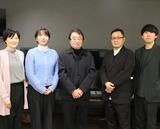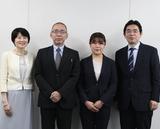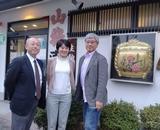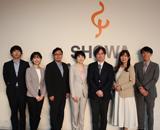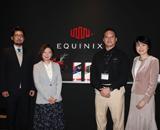January 2012
The Publishing Platform Business Rolled Out by Six Apart, Ltd.
A Content Management System (CMS) is a system that streamlines procedures related to the development and operation of a website and enhances convenience. We at Arc Communications were among the first in Japan to recognize the value of CMS and launched a CMS-based website design service eight years ago during the early days of CMS. Arc Communications already has a proven track record of introducing CMS to many websites.
Six Apart Ltd.'s Movable Type (MT) can be considered a de facto standard in CMS in Japan. Arc Communications is one of Six Apart's partner companies, and we proactively advance the adoption of MT for website construction and operation.
Six Apart, Ltd. and Arc Communications have a rather close connection. The presidents of the two companies are the alumni of the same university, acquired MBAs in the US after joining a company and also worked together as translator and supervising editor of the Japanese translation of Jeremy Wright's "Blog Marketing" (Published in 2006 by Diamond, Inc.) Meanwhile, Arc Communications was in charge of the development of Six Apart, Ltd.'s English website as well as the Chinese localization of MT.
In this issue, Ohsato spoke to Nob Seki, President & CEO of Six Apart, Ltd. about the past and future of Six Apart's business.
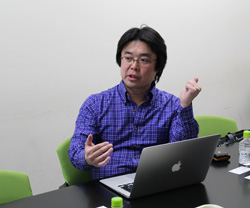
From an Engineering Major to a Magazine Reporter and on to an MBA
Ohsato: Seki-san, you worked as a reporter at a publishing house before you helped launch the Japanese subsidiary of Six Apart. Can you tell me why, after studying metallic engineering at the University of Tokyo's Faculty of Engineering, you chose to work as a reporter instead of becoming an engineer or researcher?
Nob Seki: It was because, as I was carrying out my job hunting activities before graduation, I found it interesting to have an opportunity to meet and talk to a variety of people. I also found a publishing house appealing as a way to satisfy my appetite for knowledge.
Ohsato: In my case, I left my job to study at a business school in the US in order to acquire an MBA. You also went to the States after joining a company, right? Did you also quit your job in order to study in the US?
Nob Seki: That was my original intent, but when I told my boss that I was quitting because I wanted to study business administration in America, he said, "Why quit? Why don't you come back to your job after you come back to Japan?" So, I took a leave of absence from my job to go study in the US.
Ohsato: Oh, I really envy you! But how interesting that you went from an engineering major on to become a reporter at a publishing house and then, this time, you decided to study business administration. (Laughs)
Nob Seki: I joined the publishing house in 1994. This was before the spread of the use of the Internet, and I was the only one that brought up the topic of the Internet in our editorial meetings. However, I felt that there was a future in the Internet, so I kept on talking about it in the meetings. As a result, I was finally told, "All right, since you insist, why don't you write it up?" and given permission to write an article about the Internet.
So, I spent a long time reporting on the Internet and related software. However, as the Internet industry started becoming established as a business, there was a gradual increase in talk about initial public offerings and share prices. In particular, if I interviewed the CEO of a start-up firm, all we talked about was the IPO. I did have the related knowledge on such topics that I needed as a reporter, but I began to become interested in the thinking behind starting up businesses and financial affairs. I thought that if I was going to learn more about it, the best place to study would be the US, and so I applied to a State-side business school.
An Understanding of both Engineering and Content--Participation in the Establishment of the Japanese Six Apart Subsidiary
Ohsato: How did you become involved in the establishment of the Japanese subsidiary of Six Apart?
Nob Seki: After I graduated from business school, I went back to working at the publishing house and was involved in such activities as new business development. I was then assigned to the localization of an American magazine because of my experience in the US, but that project was cancelled midway before the magazine made it to publication in Japan. It was then that I was about to find myself without any real job in the company when I was asked by Joichi Ito, Director of MIT Media Lab, if I was interested in running the Japanese subsidiary of Six Apart.
Ohsato: It must have taken quite a bit of courage to launch a Japanese subsidiary of a recently established start-up company. What attracted you to Six Apart?
Nob Seki: I think that when the use of the Internet first started spreading, websites were still quite simple in their architecture. Websites of the period were something that anyone could understand and try making. However, as a result of websites gradually becoming more sophisticated, it started becoming a world that the layman could not understand. That was when blogs started appearing. This began to allow ordinary users to distribute their own information--not just read information using a web browser. The invitation to join Six Apart came at right around that time. Joi Ito said to me, "It is a business that you should handle because you majored in engineering and have an understanding of systems but also have an understanding of content through your experience as a reporter," and he encouraged me to change careers.
Ohsato: What was Six Apart like at the time?
Nob Seki: It was very, very small when I started becoming involved. There were only about three employees in the company aside from Ben and Mena Trott, who founded Six Apart. Movable Type was already in existence, but there was nothing else. In a way, I liked the fact that the risk was not very big in comparison to the huge, worthwhile challenge that the job presented.
Six Apart Focused on the Publishing Platform Business
Ohsato: I remember thinking how awesome the US was when I saw the blog movement taking off there. With that said, however, simply bringing something from the US to Japan as is won't really work as a business, will it?
Nob Seki: Yes, I agree. If you're going to start something new, the US is the place to do it. China and other Asian countries are in the limelight these days as markets, but I think one thing that hasn't changed is that you still need to be involved in the US. But, as you say, it was very difficult when it came to making a business of it in Japan. At the time, people were saying that blogs would become the third media after television and newspapers. In fact, blogs were playing a major role as a tool against existing journalistic media and the authorities. This was the background in the US that made a blog-related advertising business feasible. However, the absolute number of readers in Japan is too small to make an advertising business possible.
If you compare the US and Japan simply on the basis of GDP, the US is only about three times bigger than Japan. However, if you compare the population of people who speak and read English with the population of those who read Japanese, the English-speaking population is about 10 to 15 times larger. Furthermore, when it comes to an advertising business, the gap becomes even bigger by about 20 to 30 times. So, when you think about the Japanese blog market just in terms of the advertising business, there is no way that you can make a profit in Japan.
Ohsato: So, that is why you focused on the publishing platform business?
Nob Seki: Exactly. We rolled out a business model in which Movable Type is used not only as a blogging tool but also as a CMS or as a platform for companies that offer blogging services to consumers.
Ohsato: I understand that all rights related to Movable Type as well as the Six Apart brand were acquired from Six Apart in the US by the Japanese Six Apart subsidiary in January 2011. What was the background to this acquisition?
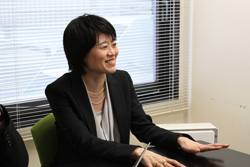
Nob Seki: As I said before, an advertising business was made possible in the US. On the other hand, the platform business did not see much growth. In Japan, however, it was the other way around, and it was the platform business that took off. In other words, the business structure differed between Japan and the US. For this reason, a state continued in which there was always a conflict for us when making any kind of investment. We decided to effectively split up the company in order to do away with the gap in the business structure.
Ohsato: In other words, you made it easier to develop your business according to each of the two markets.
Nob Seki: Yes. In the US, we now focus on developing media that contain large possibilities as a business. Japan, meanwhile, took over the platform business so that our traditional business can be expanded and developed. However, there is also talk of both the Japanese and US companies doing what they can to work together on businesses where possible, so we will continue to maintain a cooperative relationship going forward.
Sato: What are you going to do about your publishing platform business in the US?
Nob Seki: From now, the Japanese Six Apart will develop the business for the US market as well. However, the business of selling software packages is virtually unfeasible in the US, so I think that we will be reviewing a different form of distribution there.
Feature Interview Index

